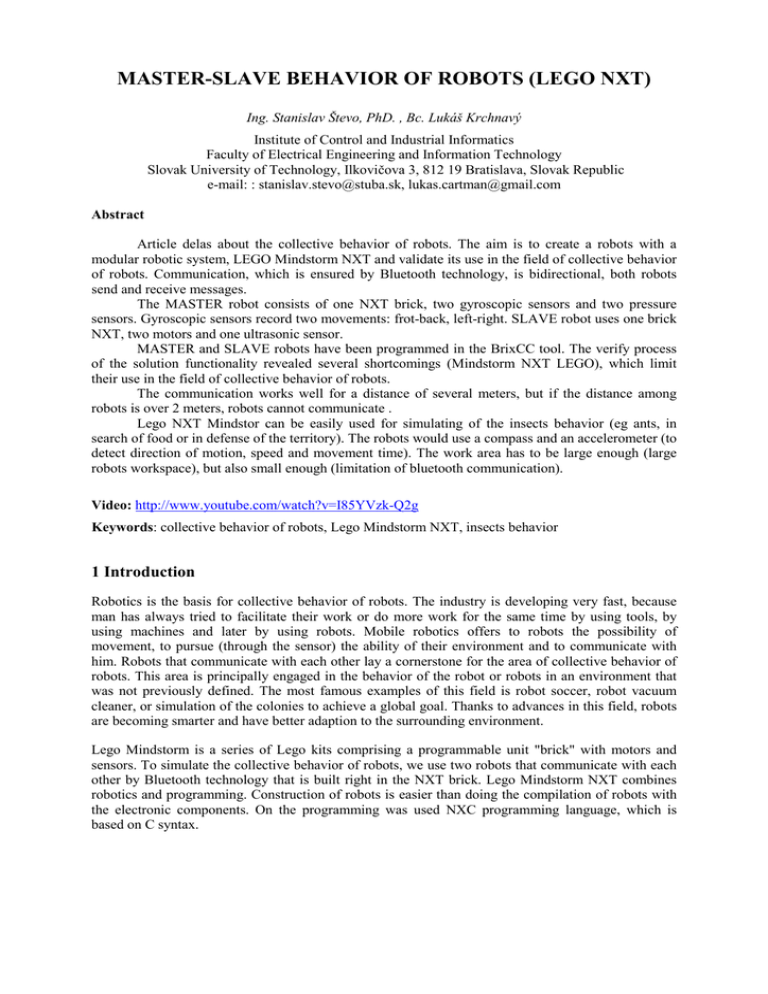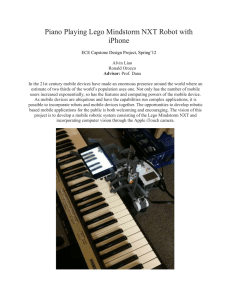master-slave behavior of robots (lego nxt)
advertisement

MASTER-SLAVE BEHAVIOR OF ROBOTS (LEGO NXT)
Ing. Stanislav Števo, PhD. , Bc. Lukáš Krchnavý
Institute of Control and Industrial Informatics
Faculty of Electrical Engineering and Information Technology
Slovak University of Technology, Ilkovičova 3, 812 19 Bratislava, Slovak Republic
e-mail: : stanislav.stevo@stuba.sk, lukas.cartman@gmail.com
Abstract
Article delas about the collective behavior of robots. The aim is to create a robots with a
modular robotic system, LEGO Mindstorm NXT and validate its use in the field of collective behavior
of robots. Communication, which is ensured by Bluetooth technology, is bidirectional, both robots
send and receive messages.
The MASTER robot consists of one NXT brick, two gyroscopic sensors and two pressure
sensors. Gyroscopic sensors record two movements: frot-back, left-right. SLAVE robot uses one brick
NXT, two motors and one ultrasonic sensor.
MASTER and SLAVE robots have been programmed in the BrixCC tool. The verify process
of the solution functionality revealed several shortcomings (Mindstorm NXT LEGO), which limit
their use in the field of collective behavior of robots.
The communication works well for a distance of several meters, but if the distance among
robots is over 2 meters, robots cannot communicate .
Lego NXT Mindstor can be easily used for simulating of the insects behavior (eg ants, in
search of food or in defense of the territory). The robots would use a compass and an accelerometer (to
detect direction of motion, speed and movement time). The work area has to be large enough (large
robots workspace), but also small enough (limitation of bluetooth communication).
Video: http://www.youtube.com/watch?v=I85YVzk-Q2g
Keywords: collective behavior of robots, Lego Mindstorm NXT, insects behavior
1 Introduction
Robotics is the basis for collective behavior of robots. The industry is developing very fast, because
man has always tried to facilitate their work or do more work for the same time by using tools, by
using machines and later by using robots. Mobile robotics offers to robots the possibility of
movement, to pursue (through the sensor) the ability of their environment and to communicate with
him. Robots that communicate with each other lay a cornerstone for the area of collective behavior of
robots. This area is principally engaged in the behavior of the robot or robots in an environment that
was not previously defined. The most famous examples of this field is robot soccer, robot vacuum
cleaner, or simulation of the colonies to achieve a global goal. Thanks to advances in this field, robots
are becoming smarter and have better adaption to the surrounding environment.
Lego Mindstorm is a series of Lego kits comprising a programmable unit "brick" with motors and
sensors. To simulate the collective behavior of robots, we use two robots that communicate with each
other by Bluetooth technology that is built right in the NXT brick. Lego Mindstorm NXT combines
robotics and programming. Construction of robots is easier than doing the compilation of robots with
the electronic components. On the programming was used NXC programming language, which is
based on C syntax.
2 Characteristics of the object examination
Challenge lies in the combination of the two NXT bricks to control slave (robot) with the MASTER
(the robot). NXT brick are named according to the tasks they will perform. The first NXT brick will be
MASTER - Driver, and hence the kind of commander who will send instructions. The second NXT
brick will be SLAVE - mobile robot, a servant who will listen to instructions.
3 Robots assembly
To compile the MASTER we used one NXT, two gyro sensors and two pressure sensors. A gyro
sensor records the rotating to front and back and the other left and right. Gyroscopic sensors are
connected to the input port 1 and 2 of NXT brick. Two pressure sensors on MASTER solve problems
related to easier stopping and easier cornering of SLAVE, which, when control by gyroscopes requires
considerable skill. Press the two pressure sensors at the same time and the SLAVE stops. After
releasing the pressure sensor the SLAVE will remain on place until we begin to move with the Master.
For easier cornering we will use the pressure sensors for cornering on place. Pressure sensors are
connected to the input port 3 and 4 of NXT brick. In Fig. 1 is shown schema of MASTER. MASTER
has been designed in order to push the pressure sensors, either individually or both at once. We have to
be careful, because the gyroscopic sensors have to be attached to the structure as shown in Fig. 1. Bad
connection to the structure, could result in management that would not work correctly.
Fig. 1: MASTER Composition
To compile the SLAVE we used the NXT brick, two motors and one ultrasonic sensor. To avoid
hitting an obstacle ahead SLAVE, it uses ultrasonic sensor. Information form ultrasonic sensor is sent
to MASTER (ensures feedback). Ultrasonic sensor is connected to input port 1 of NXT brick. The
motors are connected to the output port B and C. In Fig. 2 shows SLAVE scheme (bottom view),
because the ultrasonic sensors and motors are located under the NXT[2]. It is important that the
engines were mounted in such a position, as shown in Fig.2 (flat surface of the engine down, with
another connection the SLAVE will not work correctly).
Fig. 2: Composition SLAVE
4 Source Code
Fig. 3 describes a real form of source code, namely the function 'dopredu_dozadu'. This function
detects the direction of MASTER rotating and the rate of rotating i.e. solves rotating to back and
forward. The value of variable "x" represents the current value of output from the gyro number 1. The
function 'dostran' works in the same way as this function, but the current value of gyro number 2
represents the value of the variable "a".
void dopredu_dozadu()
{
if(x>1)
{
if(x>y)
{
if(z<100){z=z+x;}
}
}
else if(x<-1)
{
if(x<y)
{
if(z>-100){z=z+x;}
}
}
NumOut(5,LCD_LINE1,x);
NumOut(5,LCD_LINE2,y);
NumOut(5,LCD_LINE3,z);
y=x;
dostran();
}
Fig. 3: Source code function 'dopredu_dozadu'
Communication between MASTER and SLAVE is through Bluetooth wireless technology (Figure 4).
MASTER block consists of function 'main' and function 'BTCheck' and the SLAVE block consists of
a functions 'main', 'BTCheck', 'dopredu_dozadu', 'dostran' and the 'pohyb'.
Fig. 4: Relationship between MASTER and SLAVE blocks and their internal structure
5 SLAVE - The function 'dopredu_dozadu'
Flowchart function 'dopredu_dozadu' is shown in Figure 5. The function determines in which direction
is rotating the gyroscope number 1, whether it was rotated forward or backward. The first condition
("x"> 1) represents rotation to forward. The second condition ("x"> "y") determines whether the
current value of variable "x" is greater than the previous one, which was stored in the variable "y".
From this it is possible to determine that the gyroscope number 1 is rotating in the same direction, and
that his rotation did not stop. Reason for the third condition ("z" <100) is that the slave engines can
only work with values ± 100. If all three conditions met, so the value of the variable "z" added value
of the variable "x" means that the forward movement will be faster (backward slower). The following
three conditions are equivalent to the first three, but with negative numbers. A negative value of the
variable "x" represents a backward rotation. If all three conditions met, so the value of the variable "z"
added (negative) value of the variable "x" means that the backward movement will be faster (forward
slower). Last operation is run function 'dostran'.
Fig. 5: Slave - The 'dopredu_dozadu'
Conclusion
The role of the combination of the two robots using Bluetooth technology and ensure two-way
communication has been greatly simplified by using NXT LEGO Mindstorm (than to build robots
using electronics). Another advantage is the possibility of using the built-in functions for
communication via Bluetooth. Created MASTER and SLAVE robots are programmed into BrixCC.
Verifying the functionality of the solution as well as the functionality of communication between
MASTER and SLAVE revealed several shortcomings (Mindstorm NXT LEGO), which limit their use
in the field of collective behavior of robots. The first shortcoming is the number of inputs and outputs
on the NXT bricks, which limits the number of sensors and motors on a robot. This problem partially
address the products from HiTechnic [1], which provides products to expand the number of ports. The
second problem is more severe. Concerns the impact of communication via Bluetooth between
MASTER and SLAVE. Communication works very well for a distance of several meters, but if the
robots are far away from each other, the communication will be disconnected. As part of these
dimensions we can use Lego NXT Mindstor for simulating the behavior of insects (eg ants, in search
of food or in defense of the territory). The robots would use a compass and an accelerometer (to
detect direction of motion, speed and movement time). The work area must be large enough to move
the robots, but small enough to communication works correctly.
References
[1]
[2]
[3]
[4]
[5]
[6]
[7]
[8]
Robotics sensors, LEGO NXT, http://www.hitechnic.com/products
Castor bot, robot assembly process, http://www.nxtprograms.com/castor_bot/steps.html
James Floyd Kelly, Lego Mindstroms NXT – The Mayan Adventure, Apress, 2006
James Floy Kelly, Lego Mindstroms NXT-G Programming Guide, Apress, 2007
Michael Gasperi & Philippe Hurbain, Extreme NXT - Extending the Lego Mindstorms NXT to
the next level, Apress, 2007
J. S. Wang, S. N. Rong, B. P. Zhang: Researches in the walking principle and machanism of a
omnidirectional walking machine. In: International Journal of Robotics Research, 1992.
P. Štefaňák: Analýza a syntéza štruktúr mechanizmov pohonov a robotov. Veda, Bratislava
1989
Joseph L. Jones and Anita M. Flynn, Mobile Robots: Inspiration to Implementation, 2nd
edition, A K Peters, Wellesley, MA, 1999




